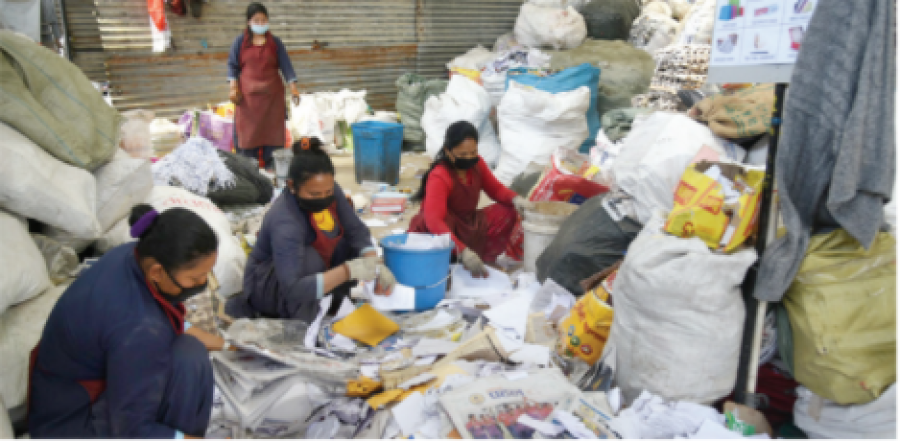Kathmandu
Kathmandu metropolis starts turning household waste into compost manure
The city office has started segregating biodegradable and non-degradable from ward 27. Degradable waste is also being used to produce biogas, which the metropolis aimed to produce electricity and use in cooking.
Post Report
The Kathmandu Metropolitan City has started making compost from biodegradable household wastes, collected from its Ward 27.
Officials said the move is part of waste management measures and if it is successful, the city office will also generate revenue for the City.
“We have started making compost from degradable wastes for the last three weeks at our waste transfer station,” said Rabinman Shrestha, chief of the Environment Department of the KMC. “We have been using reagents also for expediting the process of making compost.”
Officials hoped that the compost would be ready in two months.
Along with making compost from discarded household waste, the metropolis has been also using degradable wastes to fill in the bio-methanation plant, which was provided by the European Union.
Shrestha said that waste materials filled in a tank of biogas have just started to produce gas, which is being filled in biogas balloons. Once the gas is filled in biogas balloons, it can be used in cooking and generating electricity.
The KMC facility can generate 15 kilowatts of electricity from biogas.
Making compost from discarded waste materials, and generating biogas and electricity are among the measures the metropolis is working on to lessen the quantity of waste materials.
The city office has also started collecting segregated waste materials from ward 27, which are being collected separately. Officials said they have been working to segregate degradable and non-degradable waste materials in various places in the city.
The 32 wards of the metropolis will be divided into eight sectors and the waste materials will be segregated in the respective blocks. The metropolis has also deployed 300 cleaning staff—150 men and 150 women—to collect waste discarded at public places, including roadsides and riverbanks.
According to officials at the Environment Department of the KMC, an excavator is being used to clean the Bishnumati River. The river cleaning work has been started from the New Buspark area.
Officials said that the excavator will extract the waste from the riverside, which will be later sent to a landfill.
Waste segregation at the source was one of the measures Mayor Balendra Shah touted as a solution to Kathmandu’s chronic garbage problem. After he assumed office, Shah asked city residents to start segregating waste at the source. They started doing so, using separate bins in their homes. But the plan didn’t work, largely due to a lack of preparation on the KMC’s part.
The Kathmandu Valley generates over 1,200 tonnes of solid waste every day, nearly 60 percent of which comes from the KMC alone. Experts say 60 percent of organic waste originating in the Valley can be converted into compost and the remaining 30 percent of non-degradable waste can be recycled.
Meanwhile, the KMC has also stepped up surveillance of household waste disposal at the landfill site and started monitoring the waste management practices of health facilities.
Hospital waste management is a neglected issue in Kathmandu. Along with private health facilities, including hospitals, nursing homes, polyclinics, and laboratories, state-run health facilities also mix up hazardous medical waste with household waste.
A private organisation, which collects household garbage in the Valley, had mixed up hazardous hospital waste with household waste and taken it to a landfill site to dump, officials said, without revealing the name of the organisation.
Many health facilities including state-run hospitals do not have their own waste disposal systems. Doctors say mixing hospital waste with household waste poses a serious threat of spreading infections—HIV, Hepatitis B, Hepatitis C, tuberculosis, tetanus, and coronavirus—to those handling the waste.
Officials said that not only the metropolis’ cleaning staff but also ragpickers get injured and infected by the needles disposed of haphazardly by health facilities. The risks of spread of infections in communities grow when hazardous waste is mixed up with household waste.
It is estimated that there are over 2,100 health facilities in operation within the KMC alone. Most health facilities discard medical waste mixing it up with household waste. Some also burn such waste in the open.
Experts say burning medical waste is the worst idea as it can produce dioxin, furan and other hazardous chemicals, which can even cause cancer. Pathological waste contains harmful microorganisms—bacteria and viruses—which can easily spread if not managed properly.
A report published by the Ministry of Health and Population in 2020 showed that private hospitals were rampantly burning, burying and disposing of hazardous immunisation waste and mixing it up with municipal waste.




 18.12°C Kathmandu
18.12°C Kathmandu










